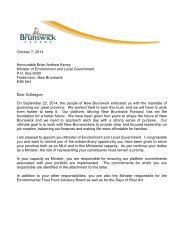cbd-ts-67-en
cbd-ts-67-en
cbd-ts-67-en
- No tags were found...
Create successful ePaper yourself
Turn your PDF publications into a flip-book with our unique Google optimized e-Paper software.
Section 2: Strategies to Address the Chall<strong>en</strong>ge of Marine Debris<br />
Duales System Deu<strong>ts</strong>chland (DSD) packaging collection and recycling program. Known as Ext<strong>en</strong>ded Producer<br />
Responsibility (EPR), the approach has be<strong>en</strong> id<strong>en</strong>tified by the Organisation of Economic Cooperation and<br />
Developm<strong>en</strong>t (OECD) as: “an <strong>en</strong>vironm<strong>en</strong>tal policy….in which a producer’s responsibility, physical and/or<br />
financial, for a product is ext<strong>en</strong>ded to the post-consumer stage of the product’s life cycle” (OECD, 2001).<br />
Traditionally, and still very commonly in most par<strong>ts</strong> of the world, waste managem<strong>en</strong>t responsibilities have<br />
defaulted to, and rested largely with municipalities, financed through public funding. Under an EPR program<br />
the producers, manufacturers, brand owners and first importers of produc<strong>ts</strong> and packaging are giv<strong>en</strong> the legal<br />
responsibility for collection, recycling and for <strong>en</strong>d-of-life managem<strong>en</strong>t. EPR programs exist across Europe,<br />
Canada and Japan for a wide range of produc<strong>ts</strong>, including packaging and plastic containers, and are being<br />
considered in countries as diverse as the United States, Brazil and Costa Rica. To date, EPR has g<strong>en</strong>erally not<br />
be<strong>en</strong> used in developing countries but it could be applied with a focus not only on brand owners but on the<br />
importers of targeted produc<strong>ts</strong> as the responsible party.<br />
The EPR approach has successfully be<strong>en</strong> used to develop sustainable producer funding for municipal recycling<br />
programs and has supported the developm<strong>en</strong>t of new marke<strong>ts</strong> for recovered packaging materials. EPR is also<br />
built on the idea that producers make decisions on types of packaging materials and have the most ability to<br />
redesign packaging to facilitate reduction, reuse and recycling. As noted in section 2.2, EPR programs have<br />
demonstrated some impact on packaging waste. Packaging EPR programs can cover cos<strong>ts</strong> through fees applied<br />
per packaging unit and fees are commonly differ<strong>en</strong>tiated based on the cos<strong>ts</strong> to recycle particular packaging<br />
materials (Stewardship Ontario, 2012). Plastics conv<strong>en</strong>tionally pay higher fees because they are more exp<strong>en</strong>sive<br />
and technically harder to segregate and recycle than materials like aluminum, steel, glass or paper.<br />
Most EPR programs for packaging are primarily focused on providing a service to resid<strong>en</strong>ces. However, a<br />
new EPR initiative for packaging in the Canadian province of British Columbia (British Columbia Recycling<br />
Regulation am<strong>en</strong>dm<strong>en</strong>t, 2011) not only gives producers a mandate for packaging waste typically found in the<br />
resid<strong>en</strong>tial waste stream, but also for packaging found in public areas such as municipal parks, on sidewalks<br />
and pedestrian areas and in city plazas and town squares. These are the kind of areas which can g<strong>en</strong>erate plastic<br />
and packaging litter which can <strong>en</strong>d up in bodies of water if not properly managed through easily accessible and<br />
available litter bins and recycling collection containers. As discussed previously, producer responsibility programs<br />
for packaging have also shown positive impac<strong>ts</strong> on packaging design and on packaging and plastics reduction.<br />
2.5 INCENTIVES FOR COLLECTION AND RECYCLING<br />
Increased diversion of plastics and packaging and prev<strong>en</strong>ting littering or disposal can be <strong>en</strong>hanced by providing<br />
inc<strong>en</strong>tives for collection and recycling.<br />
Beverage container deposit return systems are one example of such an approach with a long and prov<strong>en</strong> track<br />
record of success. Under such programs, consumers pay a deposit on the container which can be redeemed<br />
wh<strong>en</strong> the empty container is returned. Deposit return has a long history and was originally employed to <strong>en</strong>sure<br />
the return of glass bottles for reuse. In rec<strong>en</strong>t times, with the increasing use of lightweight plastic containers,<br />
such returned containers are more commonly recycled than refilled.<br />
According to the U.S. Container Recycling Institute, across the US approximately 2 out of 3 beverage containers,<br />
of all types, <strong>en</strong>d up as litter or being disposed of in landfill. Contrasted with these national statistics is data from<br />
US states which have container deposit refund programs where the recovery rate of containers for recycling<br />
ranges betwe<strong>en</strong> 66 and 96% of containers sold (Container Recycling Institute, 2001). In the Canadian province<br />
of Ontario, 94% of all glass and aluminum beer containers were returned in 2008, and wine and spirit containers<br />
which also have deposi<strong>ts</strong>, were returned at a rate of <strong>67</strong>% (CM Consulting, 2009). In both cases, relatively small<br />
returnable deposi<strong>ts</strong> of 5-20 c<strong>en</strong><strong>ts</strong> per container, or approximately 10-15 % of the product value, had a large<br />
impact on overall recovery.<br />
33



